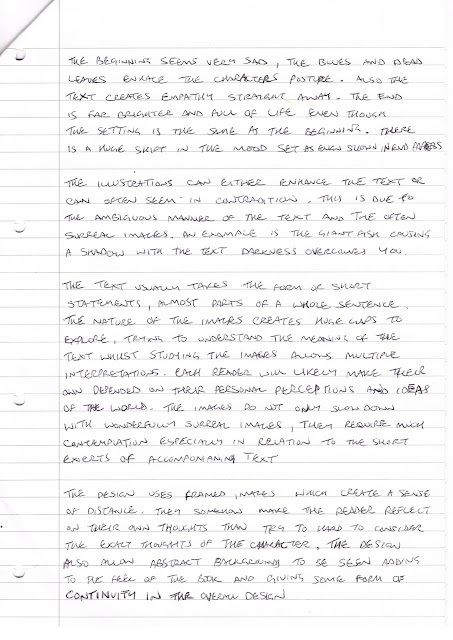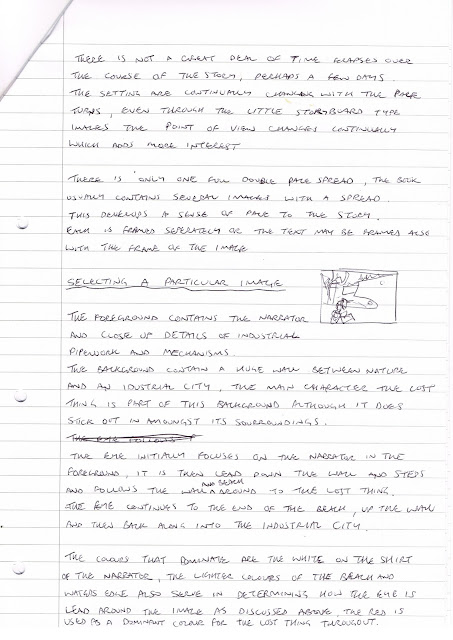Progress
This past week has been useful in that an initial framework has been created to allow works of others to be critically analysed. Three books by Shaun Tan have been analysed using this framework so far.
I am still currently behind schedule as the first two case studies were programmed for completion along with experimental works. The next two weeks were supposed to be a holiday although these plans have changed.
Reflection
The choice to take time off has put pressure on the schedule, but this is something that can be caught up in the next two weeks. The framework that has been used has worked well so far although I wish to study deeper into the works of the artist Shaun Tan. This is largely due to my interest in his work and wanting to know more upon his methods of working and to see how he and others feel about the works that I have analysed. The framework may then be adapted prior to the next case study which could be the case as each study is done. This is all to create something that will be of most benefit to my own works for this project.
Ideas
To continue with studies on Shaun Tan, adapt the framework if required. Carry out the second case study on artist Levi Pinfold. Begin experimental works taking influence from what I learn through the case studies. Use one week to do work but have one complete week off over the Christmas period. The next blog post should not be until wc 04/01/16 as I am aware of what needs to be done and should just get on with the work and post up these works at that time.
Monday, 21 December 2015
Case Study: Shaun Tan, The Red Tree
This third book will be the final book study of the work of Shaun Tan. I will now be able to carry out a comparative assessment across the three books that have been studied. Looking into methods that are used by this particular artist, comments or interviews and academic works carried out by others are all aspects that should be considered. This will give a well rounded approach to the study of this artist and may also add any issues that have not been considered through the framework used to carry out these first three studies. The study along with further explanations and images are shown below.
The end papers show in themselves the changes from the beginning to the end of the book. These are part of my thinking as to the book being about mental health, possibly bipolar disorder as the end papers seem to be extremes of both lacklustre and dull to vibrant and intense.
A similar theme is also shown through the first and last images of the story as shown above.
 |
| This image shows how the gutter is considered in designing the composition of the image itself |
The image above shows many of the repeated motifs of ladders, masks and eye that form the composition of the image and give indication towards meaning.
Case Study: Shaun Tan, The Lost Thing
 |
| The uniformity of the story or world is shown in the end papers |
The first and last images are in contrast with the first image having multiple text, images and additional information within the background. The final image seems rather bare in comparison, no text, a single image but this create a large spec for contemplation on the meaning of the story as discussed in the analysis of the work.
The image above has been analysed, how the eye is lead through the image is shown. Other aspects such as gesture, lighting have also been discussed in the analysis.
Case Study: Shaun Tan, The Rabbits
This is the first book I have studied as part of my case study on the author/illustrator Shaun Tan. Using the framework previously developed although I have decided not to use the last section as each had already been answered through the series of questions. This makes sense as it was a earlier chapter in Reading the Visual and was therefore a contributing factor towards the questions asked. This first exercise has involved only one particular image as my feelings are that when it comes to my own work I can use the set of questions to disseminate any works previously seen. These may help to solve issues as they arise, being aware of how I may tackle them is the most important factor. The notes taken are shown below, the aim is to conduct more of these studies on the work of Shaun Tan. Once a few more are done I can then compare them, hopefully any patterns or methods may become more evident. It may also show how different subject matters have been approached and why there suit that particular topic.
 |
| Prior to peritext resembles union jack and royal seal |
The contrast between the first and last images are in stark contrast in both the scale of images and the colours and overall tone of each piece as discussed in analysis.
The image above is an example of using borders and multiple images within the double spread. Tone, light and text are the main drivers in leading the eye through these images to get the narrative.
The images above show roughly the idea of the union jack having an influence on the overall composition of the work which is evident throughout the book and is discussed in the analysis.
Virtual space and time
Whilst reading the book Reading the Visual by Frank Serafini I became aware of advice he gives to his students about exposing themselves to many different artists and forms of picture books. This is something I had included in my concept development as I had realised that influence comes through exposure. Over the course of this project I have looked through many picture books but have not mentioned them in my blog. This is mainly due to me not seeing them as studies in particular but more as inspirations or making myself aware of what already exists.
One artist I had looked at was Jon Klassen and his illustrations in I Want My Hat Back and also House Held Up By Trees. The most interesting or elements that had the most impact were how he has used the illustrations to depict space and time. I Want My Hat Back has no real setting, hints of a forest are given by broken branches but the backgrounds remain fairly blank. However a sense of space is created by the direction in which the character faces. The bear seems to stroll through from left to right asking each character if they have seen his hat. Once he realises he has already seen it on one of their heads he decides to run back to get it. This means he then runs from right to left which is unusually for a picture book but it definitely works this way. This is because the character is back the way and so he must turn to go back through this virtual space that has been created. This change of direction is shown below and highlights how our minds still manage to create a sense of space or a world even if it is not shown through the illustrations themselves.


The book House Held Up By Trees manages to show a passage of time through the growth of children into adults, the dilapidation of a home left in disrepair and the reclaiming of land by nature. These elements are all shown very simply but also in such a strong manner through the illustrations that enhance the textual story being told. A long period of time is covered within this book but it is easily understood through the illustrations which are shown below.




One artist I had looked at was Jon Klassen and his illustrations in I Want My Hat Back and also House Held Up By Trees. The most interesting or elements that had the most impact were how he has used the illustrations to depict space and time. I Want My Hat Back has no real setting, hints of a forest are given by broken branches but the backgrounds remain fairly blank. However a sense of space is created by the direction in which the character faces. The bear seems to stroll through from left to right asking each character if they have seen his hat. Once he realises he has already seen it on one of their heads he decides to run back to get it. This means he then runs from right to left which is unusually for a picture book but it definitely works this way. This is because the character is back the way and so he must turn to go back through this virtual space that has been created. This change of direction is shown below and highlights how our minds still manage to create a sense of space or a world even if it is not shown through the illustrations themselves.


The book House Held Up By Trees manages to show a passage of time through the growth of children into adults, the dilapidation of a home left in disrepair and the reclaiming of land by nature. These elements are all shown very simply but also in such a strong manner through the illustrations that enhance the textual story being told. A long period of time is covered within this book but it is easily understood through the illustrations which are shown below.




Friday, 18 December 2015
Analytical Frameworks
I have used the book Reading the Visual to help me create initial frameworks for me to use in my case studies. I had made out two separate frameworks, one for textual picture books and another for wordless picture books. However I have already noticed many things in the textual that are relevant to the wordless. This means that I may well use the textual framework for both as I also left in all elements of the wordless framework when making the textual. I can remove any that do not seem relevant during the case studies. Copies of these are shown below.






Subscribe to:
Comments (Atom)





































